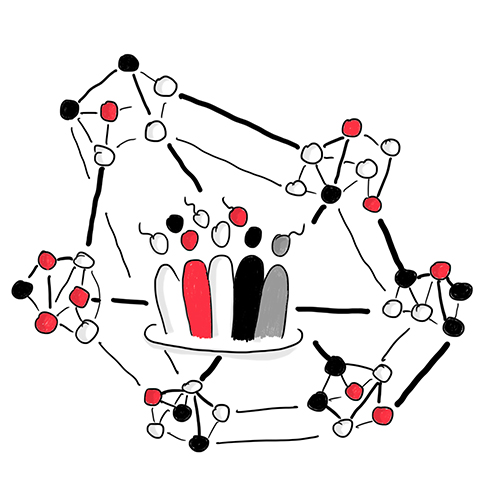To identify with a business, an organization or a group, it’s important to have a sense of belonging, shared values and a common purpose. The new types of organization hope to achieve this objective by putting in place structures that encourage, among other things, more “equitable” power-sharing, more agile decision-making and greater accountability. As we’ve seen in previous articles, it can be the case that, on the contrary, the people involved take even less responsibility.
In his book “Reinventing Organizations”, Frédéric Laloux draws three key principles from his analysis of various businesses:
- Self-management
- Wholeness, or the consideration of a person as a whole and as a unique individual
- Evolutionary purpose
Some forms of organization, such as those based on holacracy or sociocracy, put the emphasis on a person’s “role” rather than their function, or what they actually do. These persons, these roles are grouped together in circles and so forth. I don’t need to go on.
It’s interesting to note that each role defines its purpose, its raison d’être. And this gives meaning, a meaning.
Unfortunately, this exercise is often not carried out coherently and consistently. As a result, “raisons d’être” that I would call “standard” come to be defined. In fact, the raison d’être of each of these “roles” should have a direct and clear connection with the raison d’être of the business, and above all with its vision. Often, even at this level, there is confusion between the mission (raison d’être) and the vision (the place one wants to get to).
The question that every entity should ask itself is: “What is my/our contribution to the vision of the business?” – and this should be formulated right from the outset.
So, to return to the opening sentence of this article, what can be done to create an organization that really allows people to invest themselves, to feel they belong to the whole, and to take responsibility and initiative?
Let’s return to an approach which, if well applied, provides a simple, coherent and consistent answer to this question: a business consisting of several micro-enterprises. Not, of course, as a legal structure, but certainly in terms of the principles associated with it.
First, let me list some of the aspects of a classic micro-enterprise as found in our economic fabric. I will then give you some ideas on how to create micro-enterprises within your business, and therefore benefit from having entrepreneurs (or “intrapreneurs”, if you prefer).
The micro-enterprise in the current economic fabric
A micro-enterprise is a form of small-scale business characterized by its lightweight structure, simplified management and low level of economic activity. The term micro-enterprise is often used in the context of the legislation and tax regimes of certain countries, such as France.
In Switzerland, the term micro-enterprise does not have a specific legal definition. However, there is a category of small-scale businesses, known simply as small enterprises, that may be regarded as similar to the micro-enterprises of other countries.
Here are some of the main characteristics of a micro-enterprise:
- Small size: a micro-enterprise is generally defined by such criteria as having a limited number of employees or limited annual turnover.
- Legal structure: small businesses in Switzerland may be established with different legal formats, such as one-man businesses (sole traders), private limited liability companies or public limited companies. The vehicle chosen will depend on the specific needs of the entrepreneur and on the legal requirements.
- “Limited” economic activity: micro-enterprises are often limited in their business activity and turnover tends to be modest.
- Administrative and fiscal simplicity: micro-enterprises often benefit from simplified tax and administrative regimes, which makes them easier to manage. They may be subject to flat-rate tax regimes, for example, or benefit from exemption from certain social security charges.
- Limited liability: in many cases entrepreneurs who head up micro-enterprises benefit from having limited liability, which means that their financial liability is limited to the business’s assets and their personal wealth is protected.
The micro-enterprise within your business
Once the vision of your business is clear, and the values and principles of behaviour and conduct leading to its realization are defined, lived out and followed, you can work out an organic micro-enterprise structure, whereby each micro-enterprise will develop and be guided by the following points:
- What is our contribution to the vision of the business, our mission, our vision and, of course, the main objective (indicate the objective and the value it adds)?
- How often should we review this contribution?
- Who are the stakeholders and what are their expectations/needs?
- What activities are necessary to achieve the objective (the goal)?
- What inputs do we need and what are our outputs (here again, what value do these outputs add)?
- What resources do we need?
- What room for manoeuvre do we have, what can we decide, what should we decide?
- How do we measure progress towards the objective (what are our performance, progress and development indicators)? In this respect, an OKR approach is ideal (see my previous article).
Don’t forget to celebrate your successes as the various stages are reached.
An “organic” structure of this kind should ideally be made visible within the business, for example on a felt-board, on which the micro-enterprises are posted along with data on the eight points just mentioned. The inputs and outputs should be indicated with coloured threads, creating visible connections with this living organism. Like neurons, these connections will be made, unmade, and will evolve.
It is for you to decide how frequently you should or want to review this organism and its connections, thus making your business more alive and agile.
There are, of course, software packages for representing these things, but I am convinced that a visible structure of this kind, displayed within the business, is a plus that will stimulate discussion and a sense of belonging.

